Guide for Climate-Resilient Cities: An Urban Critical Infrastructures Approach
Abstract
1. Introduction
2. State of the Art
3. Methodology
- W1, W2, W3 and W4: a list of policies for improving city resilience against CC.
- W3 and W4: a classification of CI sectors by criticality against CC impacts, a CI interdependency matrix and the chain of socio-economic impacts to the society due to cascading effects.
4. Results
- Understand the urban context and CC-related crises.
- Understand urban CI networks, sectors and services.
- Assess and improve resilience.
4.1. Step 1: Understand the Urban Context and CC-Related Crises
4.2. Step 2: Understand Urban CI Networks
4.3. Step 3: Assess and Improve Resilience
- PREPAREDNESS. This dimension refers to the capacity of the city to anticipate and adapt its services and functions to future needs. It comprises city and urban CI skills for managing the unexpected in terms of knowledge, procedures and technical resources for improving their flexibility and adaptive capacity.
- LEADERSHIP. This dimension refers to city commitment to the resilience-building process and its capacity to promote and consolidate the culture, attitude and values based on it. Furthermore, it considers the capacity of the city to develop strategies involving all relevant stakeholders in the city. City leaders must ensure an accurate and stable legal and operational environment that enables and guarantees the adoption and improvement of the resilience policies.
- TECHNICAL. This dimension refers to the city infrastructures’ strength and capacity for adapting to the CC hazard and its impacts, in terms of resisting, absorbing and recovering from a triggering event, while guaranteeing the service. In this sense, CIs must carry out effective risk management and establish redundancy measures and resources to reduce vulnerabilities as well as to face and solve crises, both expected and unexpected. This includes having physical assets, staff, skills, technology, supplies and ensuring reliable and good quality information.
- COOPERATION. This dimension refers to the capacity of the city agents to work together and set and achieve common purposes. Cooperation must be developed at all levels within the city and at the supra-municipal level, involving agents belonging to the public, private and social spheres. In this dimension, policies to promote effective collaboration and agreements among all city agents with the objective of enhancing city resilience can be found. Moreover, actions that promote strategic alliances with other cities and lead to the creation of resilient cities networks must be carried out.
- EMERGING (E): The city is aware of the need, but they do not know how to operationalise it. In the emerging stage, the policies are based on basic risk assessment without considering a multi-hazard approach. Preparedness for CC impacts on the urban environment, and specifically on CIs, is still incipient. Protocols and procedures for crisis management are basic and have been developed at the sectorial level and with little to no coordination. CC is not considered in urban planning or in CI renovation and construction. The city has little knowledge about the CIs and their interdependency relationships. Coordination and cooperation among the city stakeholders are defined only for specific actions.
- MODERATE (M): Basic measures according to regulations are implemented. The objective of the actions is to reach the minimum targets (i.e., risk assessment, CO2 emissions, etc.). Policies at the moderate stage start to introduce the resilience approach. In this sense, risks are considered from a more holistic approach taking into account CC impacts. Moreover, the knowledge about critical services is improved but still lacking an overall view of the urban CIs and their interdependencies. Punctual actions to face CC are carried out at the sectorial level, although specific local regulation for CC does not exist. Cooperation among stakeholders is being formalised to face specific threats.
- ADVANCED (A): The actions carried out are coordinated with other policies and departments within the city government. In the advanced stage, the city understands the main risks, including CC-related threats, in a holistic manner but still lacks integrated plans and preparation activities, especially with regard to urban CIs. The city is developing CC adaptation plans, mainly in the environmental department, and considering a CC perspective in their urban planning. The city has improved its knowledge about CI interdependency relationships at the sectorial level. The city government, urban CIs and other relevant stakeholders establish cooperation agreements for CC-related issues.
- CONSOLIDATED (C): The actions carried out are coordinated within the city government as well as with CI providers and other relevant city stakeholders. In the consolidated stage, the city has developed coordinated plans to face risks from a multi-hazard approach in some specific situations. Those plans consider the urban CIs and other relevant stakeholders. The city is developing its resilience strategy and has CC adaptation action plans, but they are not aligned. The city has developed plans to build a CC perspective in the renovation and design of urban CIs. The city understands CIs interdependency relationships at the sectorial level, and in the most critical cases, at the local level. The city jointly develops its resilience plan with urban CIs and other relevant stakeholders.
- PROACTIVE (P): Policy development and improvement is promoted in a proactive manner among all the agents involved. In the proactive stage, the city has a resilience strategy that integrates other specific strategies such as CC plans. The city understands and manages the interdependencies of the CIs at the sectorial and local levels. Moreover, the interdependencies are managed beyond the city boundaries. The integration and coordination among all the relevant stakeholders, the city government, the CIs and other groups of interest are complete at the local level and coordinated with other relevant stakeholders at the regional level.
5. Discussion
6. Conclusions
Author Contributions
Funding
Conflicts of Interest
References
- De Coninck, H.; Revi, A.; Babiker, M.; Bertoldi, P.; Buckeridge, M.; Cartwright, A.; Dong, W.; Ford, J.; Fuss, S.; Hourcade, J.C.; et al. Strengthening and implementing the global response. In Global Warming of 1.5 °C: Summary for Policy Makers; IPCC: Geneva, Switzerland, 2018; p. 132. [Google Scholar]
- Van Oldenbourg, G.J. Trends in Weather Extremes. February 2018. Available online: https://www.worldweatherattribution.org (accessed on 21 March 2019).
- United Nations. World Urbanization Prospects: The 2018 Revision; United Nations Department of Economic and Social Affairs: New York, NY, USA, 2018; pp. 1–2. [Google Scholar]
- Füssel, H.-M.; Marx, A.; Hildén, M.; Bastrup-Birk, A.; Louwagie, G.; Wugt-Larsen, F.; Suk, J. Climate Change, Impacts and vulnerability in Europe 2016; EEA: Copenhagen, Denmark, 2017; Volume 4. [Google Scholar] [CrossRef]
- EU Commission. The EU Strategy on Adaptation to Climate Change.; EU Commission: Brussels, Belgium, 2013. [Google Scholar]
- European Commission. A Clean Planet for All. A European Strategic Long-Term Vision for a Prosperous, Modern, Competitive and Climate Neutral Economy—Communication from the Commission to the European Parliament, the Council, the European and Social Committee and the Committee; EU Commission: Brussels, Belgium, 2018; p. 25. [Google Scholar]
- Heidrich, O.; Reckien, D.; Olazabal, M.; Foley, A.; Salvia, M.; de Gregorio Hurtado, S.; Orru, H.; Flacke, J.; Geneletti, D.; Pietrapertosa, F. National climate policies across Europe and their impacts on cities strategies. J. Environ. Manag. 2016, 168, 36–45. [Google Scholar] [CrossRef] [PubMed]
- Aguiar, F.C.; Bentz, J.; Silva, J.M.; Fonseca, A.L.; Swart, R.; Santos, F.D.; Penha-Lopes, G. Adaptation to climate change at local level in Europe: An overview. Environ. Sci. Policy 2018, 86, 38–63. [Google Scholar] [CrossRef]
- Tyler, S.; Moench, M. A framework for urban climate resilience. Clim. Dev. 2012, 4, 311–326. [Google Scholar]
- Department of Homeland Security. 2017. Available online: https://www.dhs.gov/topic/critical-infrastructure-security (accessed on 15 February 2018).
- EU Critical Infrastructures. 2017. Available online: https://ec.europa.eu/home-affairs/what-we-do/policies/crisis-and-terrorism/critical-infrastructure_en (accessed on 5 March 2018).
- Torabi, E.; Dedekorkut-Howes, A.; Howes, M. Urban Resilience to Climate-Related Disasters: Emerging Lessons from Resilience Policy and Practice in Coastal Tourism Cities. In Climate Change Adaptation in Pacific Countries; Spinger: Cham, Switzerland, 2017; pp. 241–254. [Google Scholar]
- Laugé-Eizaguirre, A. Crisis Management Toolbox: The Relevant role of Critical Infrastructures and their Dependencies. PhD Thesis, University of Navarra, Pamplona, Spain, 2014. [Google Scholar]
- Mikellidou, C.V.; Shakou, L.M.; Boustras, G.; Dimopoulos, C. Energy critical infrastructures at risk from climate change: A state of the art review. Saf. Sci. 2018, 110, 110–120. [Google Scholar] [CrossRef]
- Wallace, W.A.; Sharkey, T.C.; Chow, J.H.; Mitchell, J.E.; Nguyen, H.; Nurre, S.G. Identification and Classification of Restoration Interdependencies in the Wake of Hurricane Sandy. J. Infrastruct. Syst. 2015, 22, 04015007. [Google Scholar]
- Comes, T.; Van de Walle, B. Measuring disaster resilience: The impact of Hurricane Sandy on critical infrastructure systems. In Proceedings of the Eleventh International ISCRAM Conference, University Park, PA, USA, 18–21 May 2014; pp. 195–204. [Google Scholar]
- Revi, A.; Satterthwaite, D.E.; Aragón-Durand, F.; Corfee-Morlot, J.; Kiunsi, R.B.R.; Pelling, M.; Roberts, D.C.; Solecki, W. Urban areas. In Climate Change 2014: Impacts, Adaptation, and Vulnerability. Part A: Global and Sectoral Aspects. Contribution of Working Group II to the Fifth Assessment Report of the Intergovernmental Panel on Climate Change; Field, C.B., Barros, V.R., Dokken, D.J., Mach, K.J., Mastrandrea, M.D., Bilir, T.E., Chatterjee, M., Ebi, K.L., Estrada, Y.O., Genova, R.C., et al., Eds.; Cambridge University Press: Cambridge, UK; New York, NY, USA; pp. 535–612.
- Hernantes, J.; Maraña, P.; Gimenez, R.; Sarriegi, J.M.; Labaka, L. Towards resilient cities: A maturity model for operationalizing resilience. Cities 2019, 84, 96–103. [Google Scholar] [CrossRef]
- Folke, C.; Carpenter, S.; Elmqvist, T.; Gunderson, L.; Holling, C.S. Resilience and sustainable development: Building adaptive capacity in a world of transformations. AMBIO 2002, 31, 437–440. [Google Scholar] [CrossRef]
- Hollnagel, E. Prologue: The scope of resilience engineering. In Resilience Engineering in Practice: A Guidebook; Ashgate Publishing, Ltd.: Farnham, UK, 2011; pp. 29–39. [Google Scholar]
- Holling, C.S. Resilience and stability of ecological systems. Annu. Rev. Ecol. Syst. 1973, 4, 1–23. [Google Scholar] [CrossRef]
- Madni, A.M.; Jackson, S. Towards a conceptual framework for resilience engineering. IEEE Syst. J. 2009, 3, 181–191. [Google Scholar] [CrossRef]
- Thornbush, M.; Golubchikov, O.; Bouzarovski, S. Sustainable cities targeted by combined mitigation–adaptation efforts for future-proofing. Sustain. Cities Soc. 2013, 9, 1–9. [Google Scholar] [CrossRef]
- Leong, C. Resilience to climate change events: The paradox of water (In)-security. Sustain. Cities Soc. 2018, 27, 439–447. [Google Scholar] [CrossRef]
- Curt, C.; Tacnet, J.M. Resilience of Critical Infrastructures: Review and Analysis of Current Approaches. Risk Anal. 2018, 38, 2441–2458. [Google Scholar] [PubMed]
- Bruneau, M.; Chang, S.E.; Eguchi, R.T.; Lee, G.C.; O’Rourke, T.D.; Reinhorn, A.M.; Shinozuka, M.; Tierney, K.; Wallace, W.A.; Von Winterfeldt, D. A Framework to Quantitatively Assess and Enhance the Seismic Resilience of Communities. Earthq. Spectra 2003, 19, 733–752. [Google Scholar] [CrossRef]
- Fu, G.; Wilkinson, S.; Dawson, R.J.; Fowler, H.J.; Kilsby, C.; Panteli, M.; Mancarella, P. Integrated Approach to Assess the Resilience of Future Electricity Infrastructure Networks to Climate Hazards. IEEE Syst. J. 2017, 12, 3169–3180. [Google Scholar] [CrossRef]
- Francis, R.; Bekera, B. A metric and frameworks for resilience analysis of engineered and infrastructure systems. Reliab. Eng. Syst. Saf. 2014, 121, 90–103. [Google Scholar] [CrossRef]
- Espinoza, S.; Panteli, M.; Mancarella, P.; Rudnick, H. Multi-phase assessment and adaptation of power systems resilience to natural hazards. Electr. Power Syst. Res. 2016, 136, 352–361. [Google Scholar] [CrossRef]
- Panteli, M.; Mancarella, P. Modeling and evaluating the resilience of critical electrical power infrastructure to extreme weather events. IEEE Syst. J. 2017, 11, 1733–1742. [Google Scholar] [CrossRef]
- Brown, C.; Seville, E.; Vargo, J. Measuring the organizational resilience of critical infrastructure providers: A New Zealand case study. Int. J. Crit. Infrastruct. Prot. 2017, 18, 37–49. [Google Scholar] [CrossRef]
- Bram, S.; Degerman, H.; Melkunaite, L.; Urth, T.; Carreira, E. Organisational resilience concepts applied to critical infrastructure. IMPROVER EU Project Deliverable Number: D4.3, 2016. Available online: http://improverproject.eu/2017/05/31/d-4-3-organisational-resilience-concepts-applied-to-critical-infrastructure/.
- Labaka, L.; Hernantes, J.; Sarriegi, J.M. A holistic framework for building critical infrastructure resilience. Technol. Forecast. Soc. Chang. 2016, 103, 21–33. [Google Scholar] [CrossRef]
- Shakou, L.M.; Wybo, J.L.; Reniers, G.; Boustras, G. Developing an innovative framework for enhancing the resilience of critical infrastructure to climate change. Saf. Sci. 2019, 118, 364–378. [Google Scholar]
- Eusgeld, I.; Nan, C.; Dietz, S. System-of-systems approach for interdependent critical infrastructures. Reliab. Eng. Syst. Saf. 2011, 96, 679–686. [Google Scholar] [CrossRef]
- Nan, C.; Sansavini, G. A quantitative method for assessing resilience of interdependent infrastructures. Reliab. Eng. Syst. Saf. 2017, 157, 35–53. [Google Scholar] [CrossRef]
- Sansavini, G. Engineering resilience in critical infrastructures. In NATO Science for Peace and Security Series C: Environmental Security; Springer: Berlin, Germany, 2017. [Google Scholar]
- Laugé, A.; Hernantes, J.; Sarriegi, J.M. Critical infrastructure dependencies: A holistic, dynamic and quantitative approach. Int. J. Crit. Infrastruct. Prot. 2015, 8, 16–23. [Google Scholar] [CrossRef]
- Heino, O.; Takala, A.; Jukarainen, P.; Kalalahti, J.; Kekki, T.; Verho, P. Critical Infrastructures: The Operational Environment in Cases of Severe Disruption. Sustainability 2019, 11, 838. [Google Scholar] [CrossRef]
- Chang, S.E.; McDaniels, T.L.; Mikawoz, J.; Peterson, K. Infrastructure failure interdependencies in extreme events: Power outage consequences in the 1998 Ice Storm. Nat. Hazards 2007, 41, 337–358. [Google Scholar] [CrossRef]
- Kanno, T.; Koike, S.; Suzuki, T.; Furuta, K. Human-centered modeling framework of multiple interdependency in urban systems for simulation of post-disaster recovery processes. Cogn. Technol. Work 2019, 21, 301–316. [Google Scholar] [CrossRef]
- IPCC. Summary for policymakers. In Climate Change 2014: Impacts, Adaptation, and Vulnerability; Part A Glob. Sect. Asp. Contrib. Work. Gr. II to Fifth Assess. Rep. the I Intergovernmental Panel Clim. Chang.; Cambridge University Press: Cambridge, UK; New York, NY, USA; pp. 1–32.
- Linkov, I.; Bridges, T.; Creutzig, F.; Decker, J.; Fox-Lent, C.; Kröger, W.; Lambert, J.H.; Levermann, A.; Montreuil, B.; Nathwani, J. Changing the resilience paradigm. Nat. Clim. Chang. 2014, 4, 407. [Google Scholar] [CrossRef]
- Shen, S.; Feng, X.; Peng, Z.R. A framework to analyze vulnerability of critical infrastructure to climate change: The case of a coastal community in Florida. Nat. Hazards 2016, 84, 589–609. [Google Scholar] [CrossRef]
- Lizarralde, G.; Chmutina, K.; Bosher, L.; Dainty, A. Sustainability and resilience in the built environment: The challenges of establishing a turquoise agenda in the UK. Sustain. Cities Soc. 2015, 15, 96–104. [Google Scholar] [CrossRef]
- Marchese, D.; Reynolds, E.; Bates, M.E.; Morgan, H.; Clark, S.S.; Linkov, I. Resilience and sustainability: Similarities and differences in environmental management applications. Sci. Total Environ. 2018, 613, 1275–1283. [Google Scholar] [CrossRef]
- Collier, M.J.; Nedović-Budić, Z.; Aerts, J.; Connop, S.; Foley, D.; Foley, K.; Newport, D.; McQuaid, S.; Slaev, A.; Verburg, P. Transitioning to resilience and sustainability in urban communities. Cities 2013, 32, S21–S28. [Google Scholar] [CrossRef]
- Malalgoda, C.; Amaratunga, D.; Haigh, R. Challenges in Creating a Disaster Resilient Built Environment. Procedia Econ. Financ. 2014, 18, 736–744. [Google Scholar] [CrossRef]
- Toubin, M.; Laganier, R.; Diab, Y.; Serre, D. Improving the Conditions for Urban Resilience through Collaborative Learning of Parisian Urban Services. J. Urban Plan. Dev. 2014, 141, 05014021. [Google Scholar] [CrossRef]
- Godschalk, D.R. Urban Hazard Mitigation: Creating Resilient Cities. Nat. Hazards Rev. 2003, 4, 136–143. [Google Scholar] [CrossRef]
- Meerow, S.; Newell, J.P.; Stults, M. Defining urban resilience: A review. Landsc. Urban Plan. 2016, 147, 38–49. [Google Scholar] [CrossRef]
- 100 Resilient Cities. Available online: https://www.100resilientcities.org/ (accessed on 15 May 2019).
- SMR Project. Available online: http://smr-project.eu/home/ (accessed on 15 May 2019).
- Smart Resilience. Available online: http://www.smartresilience.eu-vri.eu/ (accessed on 15 May 2019).
- IMPROVER Project. Available online: http://improverproject.eu/ (accessed on 15 May 2019).
- RESIN Project. Available online: http://www.resin-cities.eu/home/ (accessed on 15 May 2019).
- Ouyang, M.; Wang, Z. Resilience assessment of interdependent infrastructure systems: With a focus on joint restoration modeling and analysis. Reliab. Eng. Syst. Saf. 2015, 141, 74–82. [Google Scholar] [CrossRef]
- Zimmerman, R.; Restrepo, C.E. Analyzing cascading effects within infrastructure sectors for consequence reduction. In Proceedings of the IEEE Conference on Technologies for Homeland Security, HST 2009, Waltham, MA, USA, 11–12 May 2009; pp. 165–170. [Google Scholar]
- Marana, P.; Labaka, L.; Sarriegi, J.M. A framework for public-private-people partnerships in the city resilience-building process. Saf. Sci. 2018, 110, 39–50. [Google Scholar] [CrossRef]
- Voorberg, W.H.; Bekkers, V.J.J.M.; Tummers, L.G. A Systematic Review of Co-Creation and Co-Production: Embarking on the social innovation journey. Public Manag. Rev. 2015, 17, 1333–1357. [Google Scholar] [CrossRef]
- Hennink, M.M. Focus Group Discussions; Oxford University Press: Oxford, UK, 2013. [Google Scholar]
- Rinaldi, S.M. Modeling and simulating critical infrastructures and their interdependencies. In Proceedings of the 37th Annual Hawaii International Conference on System Sciences, Big Island, HI, USA, 5–8 January 2004; p. 8. [Google Scholar]
- Pescaroli, G.; Nones, M.; Galbusera, L.; Alexander, D. Understanding and mitigating cascading crises in the global interconnected system. Int. J. Disaster Risk Reduct. 2018, 30, 159–163. [Google Scholar] [CrossRef]
- ARUP. City Resilience Framework; ARUP Group Ltd.: London, UK, 2015; Available online: http://www.seachangecop.org/files/documents/URF_Bo.
- Sharifi, A.; Yamagata, Y. Resilient urban planning: Major principles and criteria. Energy Procedia 2014, 61, 1491–1495. [Google Scholar] [CrossRef]
- Sharifi, A.; Yamagata, Y. Principles and criteria for assessing urban energy resilience: A literature review. Renew. Sustain. Energy Rev. 2016, 60, 1654–1677. [Google Scholar] [CrossRef]
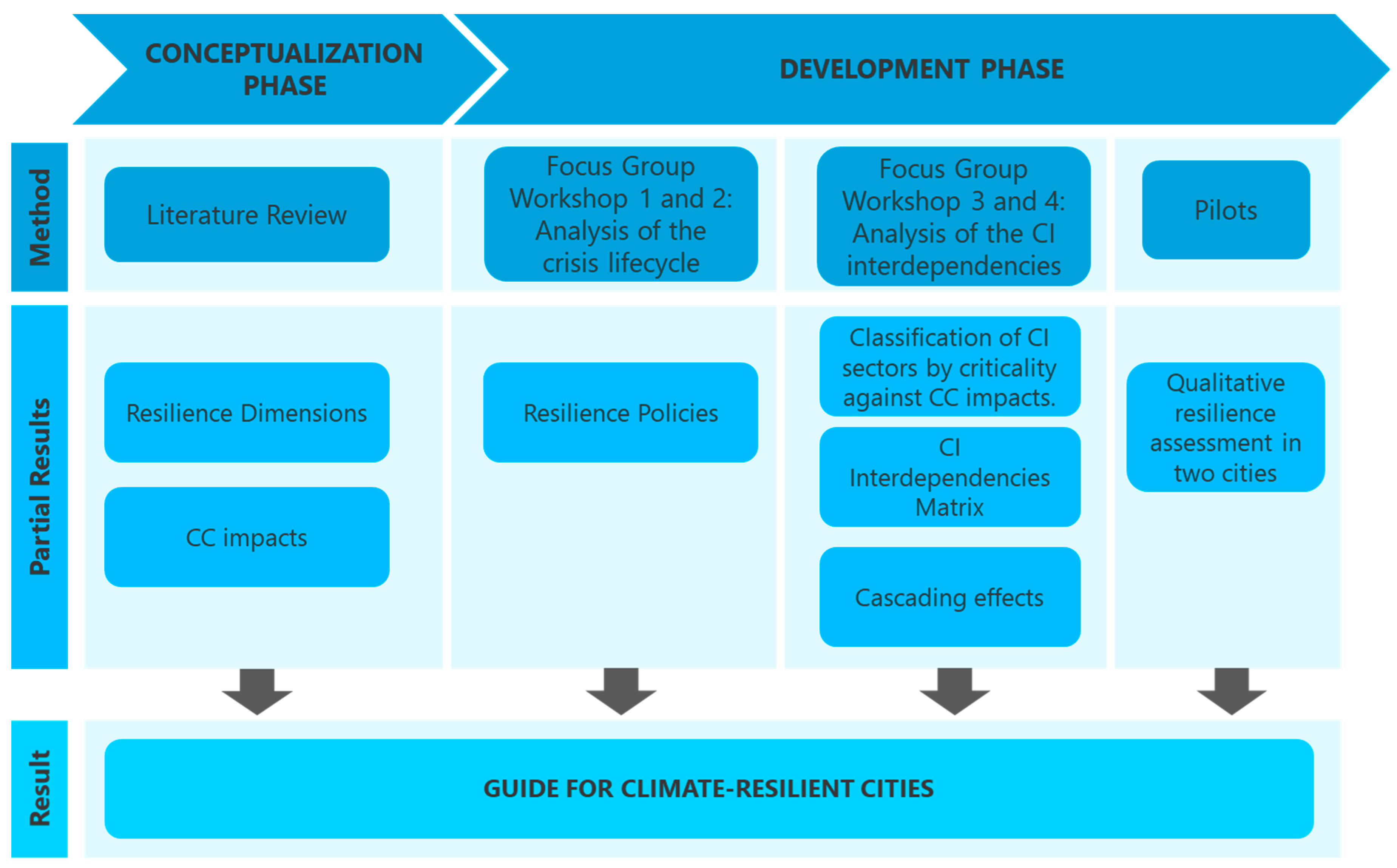
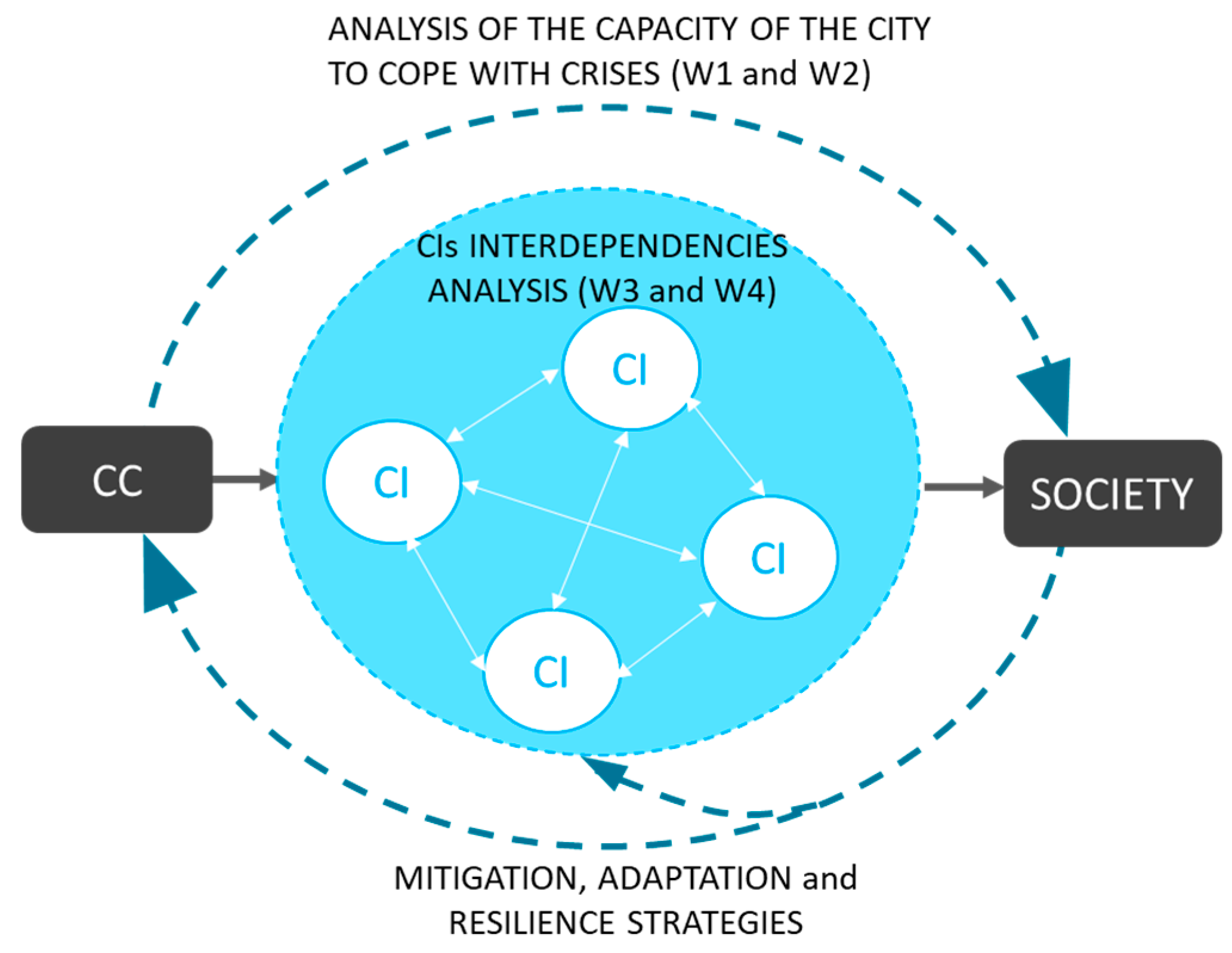
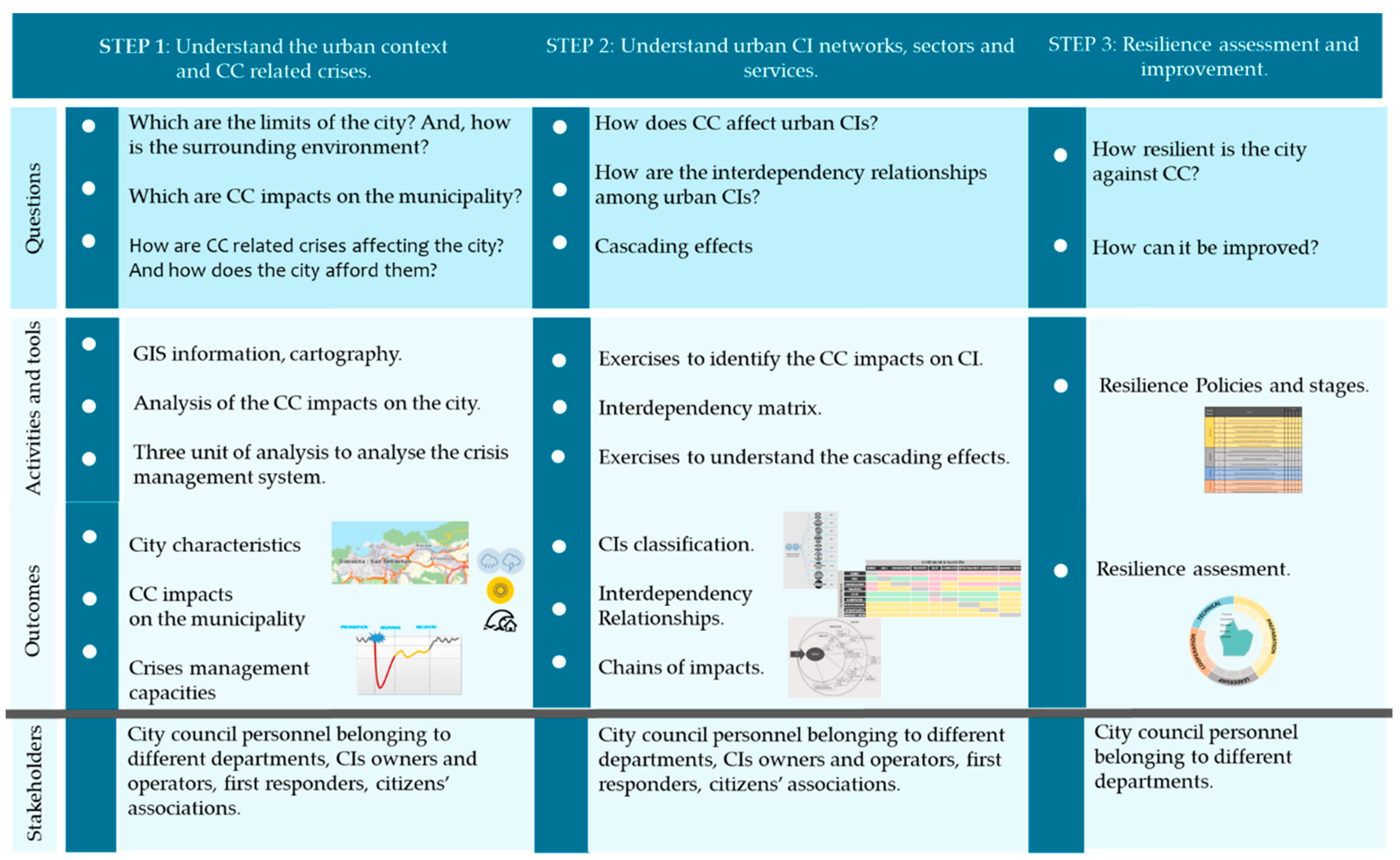
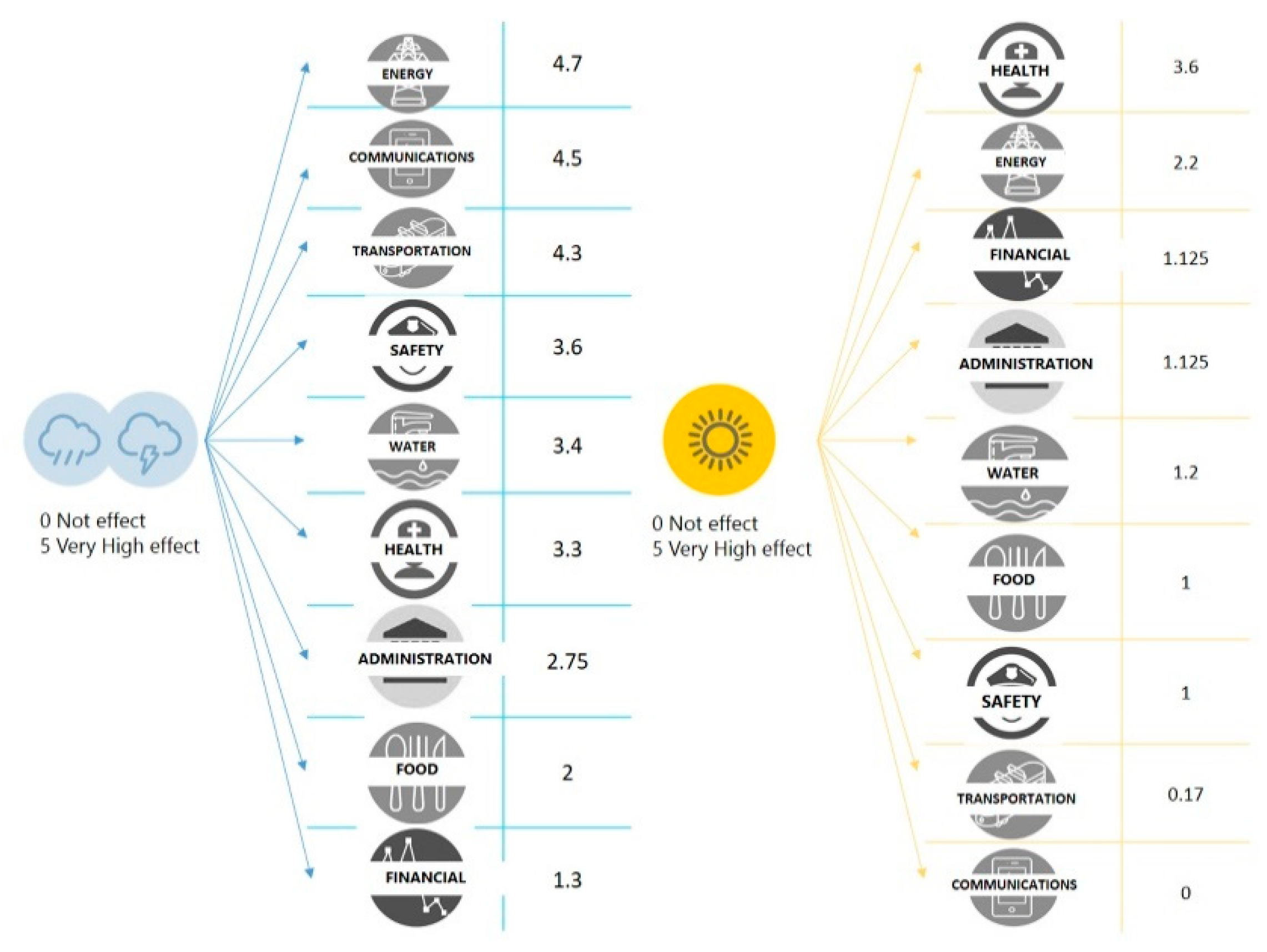

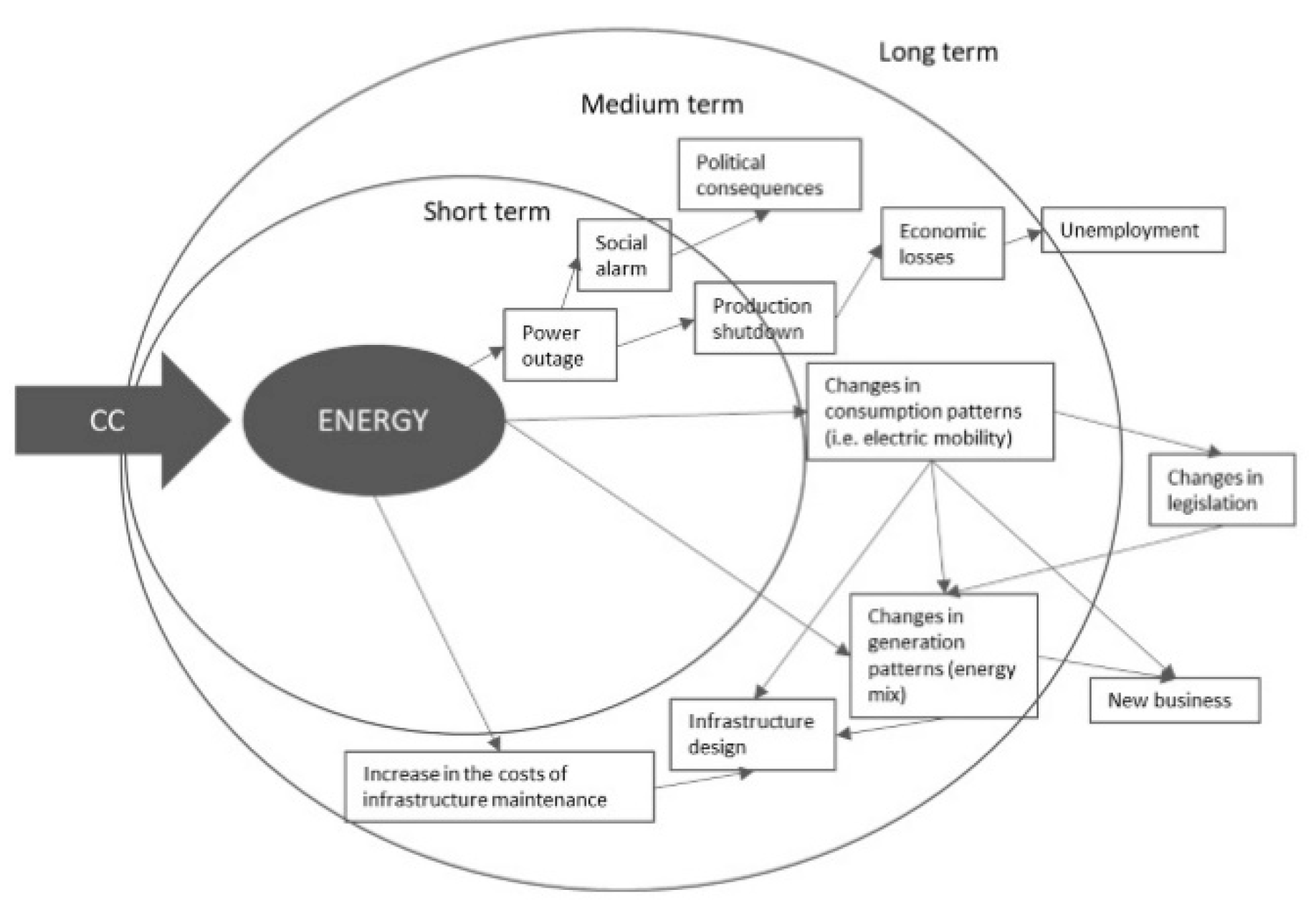
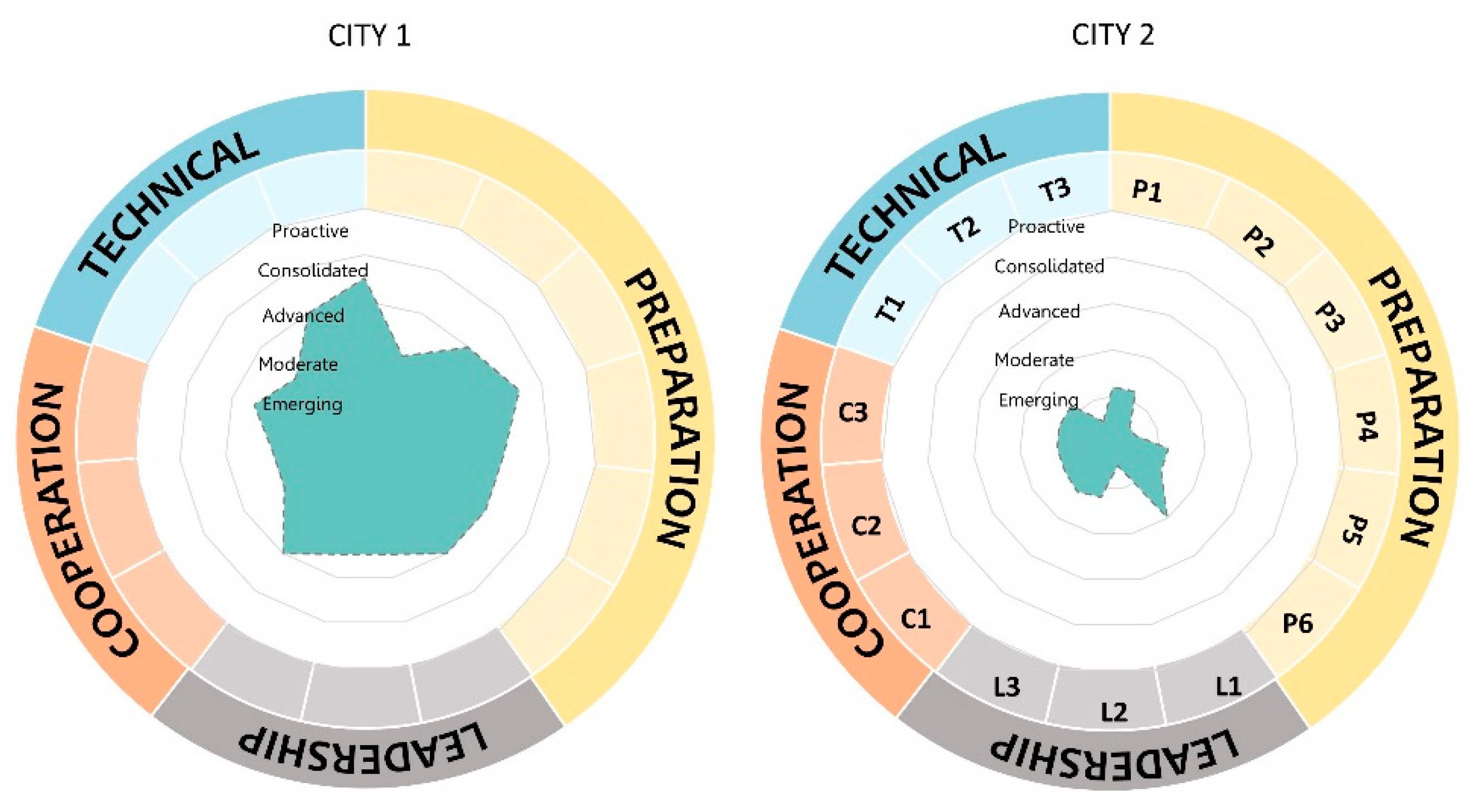
| AFFILIATION | AREA OF KNOWLEDGE (Number of Experts) |
|---|---|
| City Council (Cities 1 and 2) | Environment and climate change adaptation (4) |
| City Council (Cities 1 and 2) | Urban infrastructure maintenance (3) |
| City Council (City 1) | Strategy development (2) |
| City Council (City 2) | Social issues (1) |
| Osakidetza (Basque Country’s public health service) | Health (4) |
| Basque water agency. Provincial water agency. Aguas del Añarbe. | Water (3) |
| REE. Iberdrola | Energy (electricity) (3) |
| DonostiTIK | ICT (1) |
| Municipal police (City 2). Ertzaintza (Basque Country’s police force) | Safety and order (3) |
| Provincial council’s firefighters | First responders (1) |
| DYA. Red Cross. Civil Protection. | First responders (volunteers) (5) |
| ACTIVITIES | BARRIERS |
|---|---|
| Carry out training and drills. | Lack of political consensus on CC issues. Politicians do not take expert and CI opinion into account when legislating. Lack of knowledge about more sustainable solutions. Economic issues. Lack of citizen awareness about CC. |
| Consider CC criteria in the design and planning of new installations. | |
| Carry out risk assessment and identify critical points. | |
| Design and implement resilience plans. | |
| Promote CC awareness. | |
| Create a panel of experts to give advice to decision makers on CC issues, and keep it updated. |
| RESILIENCE DIMENSION | POLICIES | STAGE | |||||
|---|---|---|---|---|---|---|---|
| E | M | A | C | P | |||
| PREPARATION | P1 | To evaluate risks and to identify critical elements, both physical assets and management processes. | |||||
| P2 | To ensure the preparation of crisis managers and public and private agents. | ||||||
| P3 | To define, improve and update the crisis management plans. | ||||||
| P4 | To have adequate equipment and resources to face and solve crises. | ||||||
| P5 | To analyse previous crises and share the knowledge with other cities. | ||||||
| P6 | To develop activities for natural environment monitoring. | ||||||
| LEADERSHIP | L1 | To lead the resilience-building process against CC being an example for the citizenry. | |||||
| L2 | To adapt the regulations and standards to the real needs and realities applying CC criteria (energy, infrastructures, urban development, etc.). | ||||||
| L3 | To carry out activities to generate awareness in and commitment from all the city agents. | ||||||
| TECHNICAL | T1 | To ensure the reliability of the urban infrastructures. | |||||
| T2 | To renew and improve existing infrastructures by introducing CC criteria. | ||||||
| T3 | To manage CIs interdependencies at the sectorial and local levels. | ||||||
| COOPERATION | C1 | To encourage cooperation and solidarity among citizens to better face crises. | |||||
| C2 | To set collaboration agreements with CI providers to face CC. | ||||||
| C3 | To establish appropriate communication channels and people responsible for them. | ||||||
© 2019 by the authors. Licensee MDPI, Basel, Switzerland. This article is an open access article distributed under the terms and conditions of the Creative Commons Attribution (CC BY) license (http://creativecommons.org/licenses/by/4.0/).
Share and Cite
Lomba-Fernández, C.; Hernantes, J.; Labaka, L. Guide for Climate-Resilient Cities: An Urban Critical Infrastructures Approach. Sustainability 2019, 11, 4727. https://doi.org/10.3390/su11174727
Lomba-Fernández C, Hernantes J, Labaka L. Guide for Climate-Resilient Cities: An Urban Critical Infrastructures Approach. Sustainability. 2019; 11(17):4727. https://doi.org/10.3390/su11174727
Chicago/Turabian StyleLomba-Fernández, Cinta, Josune Hernantes, and Leire Labaka. 2019. "Guide for Climate-Resilient Cities: An Urban Critical Infrastructures Approach" Sustainability 11, no. 17: 4727. https://doi.org/10.3390/su11174727
APA StyleLomba-Fernández, C., Hernantes, J., & Labaka, L. (2019). Guide for Climate-Resilient Cities: An Urban Critical Infrastructures Approach. Sustainability, 11(17), 4727. https://doi.org/10.3390/su11174727





